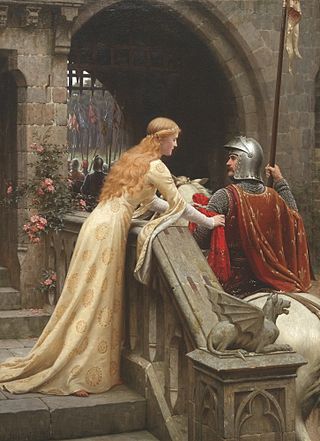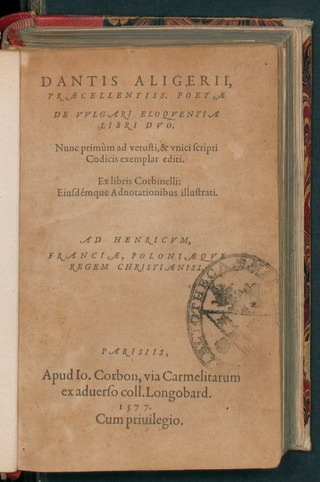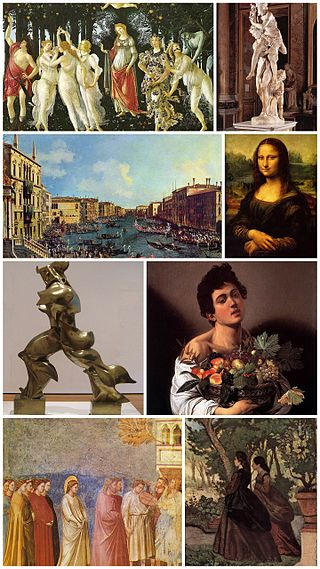Related Research Articles

Dante Alighieri, most likely baptized Durante di Alighiero degli Alighieri and often referred to as Dante, was an Italian poet, writer and philosopher. His Divine Comedy, originally called Comedìa and later christened Divina by Giovanni Boccaccio, is widely considered one of the most important poems of the Middle Ages and the greatest literary work in the Italian language.

Francesco Petrarca, commonly anglicized as Petrarch, was a scholar and poet of the early Italian Renaissance, and one of the earliest humanists.

A sonnet is a poetic form that originated in the poetry composed at the Court of the Holy Roman Emperor Frederick II in the Sicilian city of Palermo. The 13th-century poet and notary Giacomo da Lentini is credited with the sonnet's invention, and the Sicilian School of poets who surrounded him then spread the form to the mainland. The earliest sonnets, however, no longer survive in the original Sicilian language, but only after being translated into Tuscan dialect.

Courtly love was a medieval European literary conception of love that emphasized nobility and chivalry. Medieval literature is filled with examples of knights setting out on adventures and performing various deeds or services for ladies because of their "courtly love". This kind of love is originally a literary fiction created for the entertainment of the nobility, but as time passed, these ideas about love changed and attracted a larger audience. In the high Middle Ages, a "game of love" developed around these ideas as a set of social practices. "Loving nobly" was considered to be an enriching and improving practice.

Modern lyric poetry is a formal type of poetry which expresses personal emotions or feelings, typically spoken in the first person.

Gabriel Charles Dante Rossetti, generally known as Dante Gabriel Rossetti, was an English poet, illustrator, painter, translator, and member of the Rossetti family. He founded the Pre-Raphaelite Brotherhood in 1848 with William Holman Hunt and John Everett Millais. Rossetti inspired the next generation of artists and writers, William Morris and Edward Burne-Jones in particular. His work also influenced the European Symbolists and was a major precursor of the Aesthetic movement.

La Vita Nuova or Vita Nova is a text by Dante Alighieri published in 1294. It is an expression of the medieval genre of courtly love in a prosimetrum style, a combination of both prose and verse.
Terza rima is a rhyming verse form, in which the poem, or each poem-section, consists of tercets with an interlocking three-line rhyme scheme: The last word of the second line in one tercet provides the rhyme for the first and third lines in the tercet that follows. The poem or poem-section may have any number of lines, but it ends with either a single line or a couplet, which repeats the rhyme of the middle line of the previous tercet.
Dolce Stil Novo, Italian for "sweet new style," is the name given to a literary movement in 13th and 14th century Italy. Influenced by the Sicilian School and Tuscan poetry, its main theme is Divine Love. The name Dolce Stil Novo was used for the first time by Dante Alighieri in Purgatorio, the second canticle of the Divina Commedia. In the Divina Commedia Purgatory he meets Bonagiunta Orbicciani, a 13th-century Italian poet, who tells Dante that Dante himself, Guido Guinizelli, and Guido Cavalcanti had been able to create a new genre: a stil novo.

Guido Cavalcanti was an Italian poet. He was also a friend and intellectual influence on Dante Alighieri.

De vulgari eloquentia is the title of a Latin essay by Dante Alighieri. Although meant to consist of four books, it abruptly terminates in the middle of the second book. It was probably composed shortly after Dante went into exile, circa 1302–1305.

Italian literature is written in the Italian language, particularly within Italy. It may also refer to literature written by Italians or in other languages spoken in Italy, often languages that are closely related to modern Italian, including regional varieties and vernacular dialects.

The Sicilian School was a small community of Sicilian and mainland Italian poets gathered around Frederick II, most of them belonging to his imperial court in Palermo. Headed by Giacomo da Lentini, they produced more than 300 poems of courtly love between 1230 and 1266, the experiment being continued after Frederick's death by his son, Manfred.

The Trecento refers to the 14th century in Italian cultural history.

Giacomo da Lentini, also known as Jacopo da Lentini or with the appellative Il Notaro, was an Italian poet of the 13th century. He was a senior poet of the Sicilian School and was a notary at the court of the Holy Roman Emperor Frederick II. Giacomo is credited with the invention of the sonnet. His poetry was originally written in literary Sicilian, though it only survives in Tuscan.

Il Canzoniere, also known as the Rime Sparse, but originally titled Rerum vulgarium fragmenta, is a collection of poems by the Italian humanist, poet, and writer Petrarch.

In Old Occitan literature, a tornada refers to a final, shorter stanza that appears in lyric poetry and serves a variety of purposes within several poetic forms. The word tornada derives from the Old Occitan in which it is the feminine form of tornat, a past participle of the verb tornar. It is derived from the Latin verb tornare.
Dante da Maiano was a late thirteenth-century poet who composed mainly sonnets in Italian and Occitan. He was an older contemporary of Dante Alighieri and active in Florence.
Chiaro Davanzati was an Italian poet from Florence, one of the Siculo-Tuscan poets, who introduced the style of Sicilian School to the Tuscan School. He was one of the most prolific Italian authors before Dante: at least 122 sonnets and sixty-one canzoni by Chiaro are known, many of them in tenzone with other poets. Only Guittone d'Arezzo produced more lyrics in the thirteenth century.

Thomas Goddard Bergin was an American scholar of Italian literature, who was "noted particularly for his research on Dante's Divine Comedy and for its translation". He was the Sterling Professor of Romance Languages at Yale University, and Master of Timothy Dwight College. He is the first poet to have his words launched into outer space to orbit the Earth.
References
- 1 2 Hainsworth, Peter; Robey, David, eds. (2005), "Bondie Dietaiuti", The Oxford Companion to Italian Literature, Oxford Reference, ISBN 9780191727436
- 1 2 3 Cellerino, Liana (1991), "Dietaiuti, Bondie", Dizionario Biografico degli Italiani (in Italian), vol. 39
- ↑ Durling, Robert M. (2010), The Divine Comedy of Dante Alighieri, Volume 3: Paradiso, Oxford University Press, pp. 413–414, ISBN 9780199723355 .